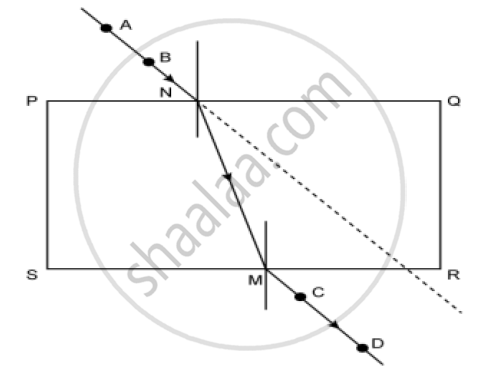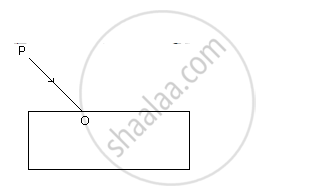Advertisements
Advertisements
प्रश्न
The velocity of light in diamond is 121000 kms-1. What is its refractive index?
उत्तर
Speed of light in diamond = 121,000 km/s
= 121 × 106 m/s
Refractive index of diamond = `"Speed of light in air"/"speed of light in diamond"`
= `(3xx10^8)/(121xx10^6"m/s")`
= 2.48
APPEARS IN
संबंधित प्रश्न
When a ray of light travels from air to glass slab and strikes the surface of separation at 90°, then it …………….
(a) bends towards normal
(b) bends away from normal
(c) passes unbent
(d) passes in zigzag way
On the basis of the experiment, "To trace the path of a ray of light through a rectangular glass slab", students of a class arrived at which one of the following conclusions?
(A) Angle of incidence is greater than the angle of emergence.
(B) Angle of emergence is smaller than the angle of refraction.
(C) Emergent ray is parallel to the refracted ray.
(D) Incident ray and emergent ray are parallel to each other.
Observe the following figure and answer the questions given under it:

1) How many times does refraction take place in the above figure?
2) What happens to the ray of light when it passes from air to glass?
3) What happens to the ray of light when it passes from glass to air?
4) What are the rays AB and CD in the figure called?
5) Define refraction.
Write the relation between the angle of incidence and the angle of refraction for a medium.
A light ray in passing from water to a medium
(a) speeds up
(b) slows down. In each case, give one example of the medium.
In the fig., PO is a ray of light incident on a rectangular glass block.
(a) Complete the path of the ray through the block.
(b) In the diagram, mark the angle of incidence (i) and the angle of refraction (r) at the first interface. How is the refractive index of glass related to the angles I and r?
(c) Mark angle of emergence by the letter e. How are the angles i and e related?
(d) Which two rays are parallel to each other? Name them.
(e) Indicate in the diagram the lateral displacement between the emergent ray and the incident ray.

How does the deviation produced by a prism depend on the wavelength of incident light?
Explain with the help of a diagram of how fish is able to see the objects above it.
Observe the figure and name the ray AB, ray CD, ray GH.

Which colour of white light travels fastest in any medium except air?
